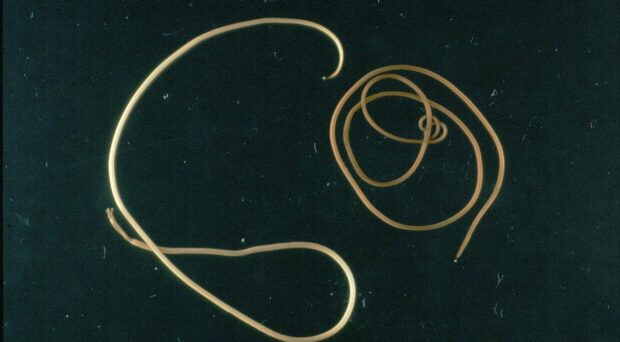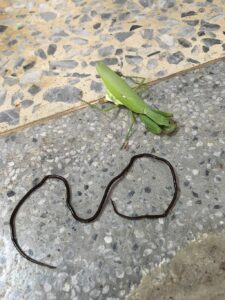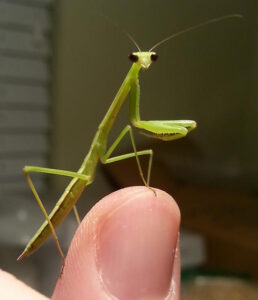
The bizarre way in which parasitic infections can alter the behaviour of their host hold a special fascination. These behavioural changes often expose the host to greater risk of predation by the parasite’s definitive host, thus enhancing the parasite’s prospect of transmission. The mechanism underlying these behavioural changes have been the subject of much debate. Are they the result of so-called manipulation molecules, produced by the parasite (an example of the extended phenotype theory), or the result of host engendered responses to infection?
Horsehair worms
One group of parasites that cause a spectacular change in the behaviour of their hosts are the nematomorphs. Known as horsehair worms because of their shape and occasional appearance in horse water-troughs, the adults are free living and found in damp or aquatic environments, whereas the larvae infect arthropods, usually insects.
Nematomorph infections in two groups of insect hosts, the crickets and mantids, have been investigated in some detail. Crickets and mantids usually shun open areas and water bodies because of the risk of exposure to predators, However, when infected with one or more horsehair worms, they wander to large water bodies, attracted by the horizontally polarised light the water gives off. Here they launch themselves into the water, potentially committing suicide.

As they struggle to stay afloat the long thin horsehair worms emerge from their bodies and swim away. Many of the hosts drown but, if they can make it to the bank, it has been observed that they can survive the infection and subsequent ducking. The adult worms mate, eggs hatch in the water and the horsehair worm larvae infect aquatic insect larvae. They remain in their insect host until it emerges from the water and, if this infected insect is predated by the horsehair worm’s primary host, the life cycle is completed (If you’ve not come across these parasites before I recommend viewing this video).
The mechanism underlying host manipulation.
In 2005, a proteomics study of horsehair worms infecting crickets showed that the parasites produce molecules that alter the central nervous system of the host. Two proteins were found to be homologous to proteins found in the cricket, suggesting a case of molecular mimicry.
This suggestion has recently been reinforced by a publication from a team from the RIKEN Center for Biosystems Dynamics Research in Japan, led by Tappei Mishina. This group investigated the parasitic nematomorph, Chordodes fukuii, and its host, the narrow-winged mantis, Tenodera angustipennis.

Field-collected mantids were held in water. If nematomorphs emerged it was assumed that they were mature and host manipulation would be occurring. The presence of immature nematomorphs that did not emerge was regarded as a pre-manipulation state. Nematomorphs kept for several days after emergence were regarded as post-manipulation and uninfected mantids were controls. Comprehensive transcriptome analysis was performed on whole body RNA collected from whole nematomorphs, and just from the brains of mantids, at these different stages.
Over 3,000 up-regulated and over 1,500 down-regulated genes were detected in nematomorphs during the manipulation phase, whereas mantid brains did not show clear distinction between any phases. This strongly supported the hypothesis that nematomorphs were producing manipulation molecules that mimic host molecules to control aspects of host behaviour.
Horizontal gene transfer
Molecular mimicry could occur in two possible ways, by convergent evolution or by horizontal gene transfer. The former would result in the production of proteins that have similar 3D structures to host molecules, but with genes that do not have sequence similarity. In contrast, close sequence similarity between parasite genes and those host genes that they mimic would be seen, if horizontal gene transfer had occurred.
To address the possibility that molecular mimicry had occurred, the researchers performed protein and nucleotide homology searches against several nematomorphs and mantids. Almost 100% identity occurred between genes from different species of mantid. However, 1,420 of C. fukuii genes were found to have high sequence homology with their mantid host, but not with other nematomorph species.
The authors cautiously conclude that multiple horizontal gene transfer from mantid to nematomorph is at least partly responsible for their ability to manipulate host behaviour, though how they affect the manipulation remains to be discovered.
Furthermore, they suggest a general role for horizontal gene transfer to have occurred in the genome evolution of other manipulative parasites and suggest the methodology used in this study could be applied widely to elucidate this proposal.
As they state, there is very little evidence of horizontal gene transfer between multicellular eukaryotes. This makes they findings particularly exciting and it is to be hoped that many more manipulative parasite / host associations are investigated in this way.

Comments